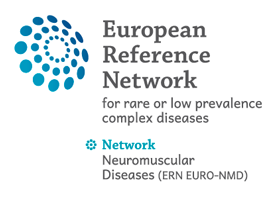24 Jul 4400
A study of the phenotypic variability and disease progression in Laing myopathy through the evaluation of muscle imaging
Authors:
Nuria Muelas, Marina Frasquet, Fernando Más‐Estellés, Pilar Martí, Laura Martínez‐Vicente, Teresa Sevilla, Inmaculada Azorín, Javier Poyatos‐García, Herminia Argente‐Escrig, Roger Vílchez, Juan F. Vázquez‐Costa, Luis Bataller, Juan J. Vilchez
Background
Laing myopathy is characterized by a broad clinical and pathological variability. Muscle imaging studies are limited. We aim to delineate muscle imaging profiles and validate imaging analysis as an outcome measure.
Methods
Cross‐sectional and longitudinal cohort study. Clinical, functional and semi‐quantitative muscle imaging (60 MRI/6 CT‐scan) data was studied. Hierarchical analysis, graphic heatmap representation and correlation between imaging and clinical data by Bayesian statistic were performed.
Results
Cohort of 42 patients from 13 families harbouring five MYH7 mutations. They displayed wide range of age, age at onset, disease duration, myopathy extension and Gardner‐Medwin‐Walton (GMW) functional scores. Intramuscular fat was evident in all but two asymptomatic/pauci‐symptomatic subjects. Anterior leg compartment muscles were the only affected in 12% of the cases. Widespread extension to thigh, hip, paravertebral and calf and less frequently scapulohumeral muscles was commonly observed, depicting distinct patterns and rates of progression. Foot muscles were involved in 40% of cases, evolving in parallel to other regions in a non‐disto‐proximal gradient. The whole cumulative imaging score ranging from 0 to 2.9 out of 4 was associated with disease duration and myopathy extension and GMW scales. Follow‐up MRI studies in 24 patients documented significant score progression at a variable rate.
Conclusions
We confirmed that the anterior leg compartment is systematically affected in Laing myopathy and it may represent the only manifestation. However, widespread muscle involvement in preferential but variable and not distance‐dependent patterns were frequently observed. Imaging score analysis is useful to categorize patients and to follow disease progression over time.

